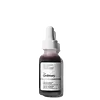What's inside
What's inside
 Key Ingredients
Key Ingredients

 Benefits
Benefits

 Concerns
Concerns

 Ingredients Side-by-side
Ingredients Side-by-side

Glycolic Acid
BufferingWater
Skin ConditioningAloe Barbadensis Leaf Water
MaskingSodium Hydroxide
BufferingDaucus Carota Sativa Extract
PerfumingPropanediol
SolventCocamidopropyl Dimethylamine
EmulsifyingSalicylic Acid
MaskingLactic Acid
BufferingTartaric Acid
BufferingCitric Acid
BufferingPanthenol
Skin ConditioningSodium Hyaluronate Crosspolymer
HumectantTasmannia Lanceolata Fruit/Leaf Extract
AntioxidantGlycerin
HumectantPentylene Glycol
Skin ConditioningXanthan Gum
EmulsifyingPolysorbate 20
EmulsifyingTrisodium Ethylenediamine Disuccinate
Potassium Sorbate
PreservativeSodium Benzoate
MaskingEthylhexylglycerin
Skin Conditioning1,2-Hexanediol
Skin ConditioningCaprylyl Glycol
EmollientGlycolic Acid, Water, Aloe Barbadensis Leaf Water, Sodium Hydroxide, Daucus Carota Sativa Extract, Propanediol, Cocamidopropyl Dimethylamine, Salicylic Acid, Lactic Acid, Tartaric Acid, Citric Acid, Panthenol, Sodium Hyaluronate Crosspolymer, Tasmannia Lanceolata Fruit/Leaf Extract, Glycerin, Pentylene Glycol, Xanthan Gum, Polysorbate 20, Trisodium Ethylenediamine Disuccinate, Potassium Sorbate, Sodium Benzoate, Ethylhexylglycerin, 1,2-Hexanediol, Caprylyl Glycol
Aloe Barbadensis Leaf
MaskingWater
Skin ConditioningSunfloweramide Mea
CleansingIsopropyl Palmitate
EmollientGlyceryl Stearate Se
EmulsifyingCetyl Alcohol
EmollientHyaluronic Acid
HumectantStearic Acid
CleansingShellac
EmollientSimmondsia Chinensis Seed Oil
EmollientPantothenic Acid
Skin ConditioningTocopherol
AntioxidantCitrus Aurantium Bergamia Fruit Oil
MaskingMelissa Officinalis Leaf Oil
MaskingGlycolic Acid
BufferingGanoderma Lucidum Extract
Skin ProtectingSalix Alba Bark Extract
AstringentDipotassium Glycyrrhizate
HumectantMelissa Officinalis Flower/Leaf/Stem Extract
SoothingPanax Ginseng Root Water
MaskingAnise Alcohol
PerfumingHorseradish Peroxidase
Skin ConditioningSchisandrin
BleachingHorse Fat
Skin ConditioningTaraxacum Officinale Extract
Skin ConditioningCentella Asiatica Extract
CleansingPelargonium Graveolens Oil
MaskingCamellia Sinensis Leaf Extract
AntimicrobialXanthan Gum
EmulsifyingPhenoxyethanol
PreservativeEthylhexylglycerin
Skin ConditioningCitrus Aurantium Bergamia Peel Oil
Citrus Aurantium Dulcis Peel Oil
MaskingCitrus Limon Peel Oil
MaskingRose Flower Oil
MaskingAloe Barbadensis Leaf, Water, Sunfloweramide Mea, Isopropyl Palmitate, Glyceryl Stearate Se, Cetyl Alcohol, Hyaluronic Acid, Stearic Acid, Shellac, Simmondsia Chinensis Seed Oil, Pantothenic Acid, Tocopherol, Citrus Aurantium Bergamia Fruit Oil, Melissa Officinalis Leaf Oil, Glycolic Acid, Ganoderma Lucidum Extract, Salix Alba Bark Extract, Dipotassium Glycyrrhizate, Melissa Officinalis Flower/Leaf/Stem Extract, Panax Ginseng Root Water, Anise Alcohol, Horseradish Peroxidase, Schisandrin, Horse Fat, Taraxacum Officinale Extract, Centella Asiatica Extract, Pelargonium Graveolens Oil, Camellia Sinensis Leaf Extract, Xanthan Gum, Phenoxyethanol, Ethylhexylglycerin, Citrus Aurantium Bergamia Peel Oil, Citrus Aurantium Dulcis Peel Oil, Citrus Limon Peel Oil, Rose Flower Oil
 Reviews
Reviews

Alternatives
Ingredients Explained
These ingredients are found in both products.
Ingredients higher up in an ingredient list are typically present in a larger amount.
Ethylhexylglycerin (we can't pronounce this either) is commonly used as a preservative and skin softener. It is derived from glyceryl.
You might see Ethylhexylglycerin often paired with other preservatives such as phenoxyethanol. Ethylhexylglycerin has been found to increase the effectiveness of these other preservatives.
Glycolic Acid is arguably the most famous alpha hydroxy acid (AHA) with tons of research backing its benefits.
It is found naturally in sugar cane but the form used in skincare is usually synthetic for purity and stability.
Glycolic acid removes the top layer of dead skin cells to allow newer and fresher ones to emerge.
AHAs work by breaking down the structural “glue” that holds old skin cells in place. When that buildup is gone, your skin can renew itself more efficiently.
Research also shows glycolic acid stimulates collagen production, helping to firm and thicken the skin over time. This is one of its biggest advantages over other AHAs.
Overall, glycolic acid helps with:
Fun fact: Glycolic acid boosts skin hydration by helping it produce molecules that increase hyaluronic acid naturally.
To work best, glycolic acid products should have a pH between 3-4 (that’s where exfoliation is most effective but still gentle on skin).
The pH and concentration of a product are key to its effectiveness:
It is normal to feel a slight stinging sensation when using glycolic acid. This usually fades as your skin adjusts.
Because glycolic acid has the smallest molecular size in the AHA family, it can penetrate deeper, which enhances its effectiveness but also makes it more likely to irritate sensitive skin.
If your skin is very sensitive or prone to rosacea, glycolic acid may be too strong; in that case, try milder options like lactic acid or a PHA instead.
Recent studies suggest glycolic acid might even help protect against UV damage. But don’t skip sunscreen! Freshly exfoliated skin is more sensitive to the sun.
Glycolic acid is a skincare superstar. It smooths, brightens, hydrates, and firms the skin. Unless you’re highly sensitive, it’s well worth adding to your routine.
Read more about some other popular AHA's here:
Learn more about Glycolic AcidWater. It's the most common cosmetic ingredient of all. You'll usually see it at the top of ingredient lists, meaning that it makes up the largest part of the product.
So why is it so popular? Water most often acts as a solvent - this means that it helps dissolve other ingredients into the formulation.
You'll also recognize water as that liquid we all need to stay alive. If you see this, drink a glass of water. Stay hydrated!
Learn more about WaterXanthan gum is used as a stabilizer and thickener within cosmetic products. It helps give products a sticky, thick feeling - preventing them from being too runny.
On the technical side of things, xanthan gum is a polysaccharide - a combination consisting of multiple sugar molecules bonded together.
Xanthan gum is a pretty common and great ingredient. It is a natural, non-toxic, non-irritating ingredient that is also commonly used in food products.
Learn more about Xanthan Gum